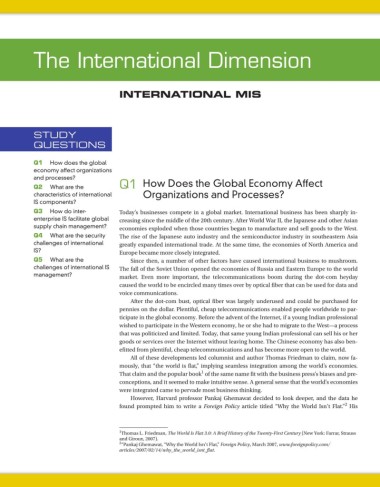Page 533 - Using MIS
P. 533
The International Dimension
InternatIonal MIS
Study
QueStionS
Q1 How does the global
economy affect organizations
and processes?
Q2 What are the Q1 How Does the Global Economy Affect
characteristics of international Organizations and Processes?
IS components?
Q3 How do inter- Today’s businesses compete in a global market. International business has been sharply in-
enterprise IS facilitate global creasing since the middle of the 20th century. After World War II, the Japanese and other Asian
supply chain management? economies exploded when those countries began to manufacture and sell goods to the West.
Q4 What are the security The rise of the Japanese auto industry and the semiconductor industry in southeastern Asia
challenges of international greatly expanded international trade. At the same time, the economies of North America and
IS? Europe became more closely integrated.
Q5 What are the Since then, a number of other factors have caused international business to mushroom.
challenges of international IS The fall of the Soviet Union opened the economies of Russia and Eastern Europe to the world
management? market. Even more important, the telecommunications boom during the dot-com heyday
caused the world to be encircled many times over by optical fiber that can be used for data and
voice communications.
After the dot-com bust, optical fiber was largely underused and could be purchased for
pennies on the dollar. Plentiful, cheap telecommunications enabled people worldwide to par-
ticipate in the global economy. Before the advent of the Internet, if a young Indian professional
wished to participate in the Western economy, he or she had to migrate to the West—a process
that was politicized and limited. Today, that same young Indian professional can sell his or her
goods or services over the Internet without leaving home. The Chinese economy has also ben-
efitted from plentiful, cheap telecommunications and has become more open to the world.
All of these developments led columnist and author Thomas Friedman to claim, now fa-
mously, that “the world is flat,” implying seamless integration among the world’s economies.
1
That claim and the popular book of the same name fit with the business press’s biases and pre-
conceptions, and it seemed to make intuitive sense. A general sense that the world’s economies
were integrated came to pervade most business thinking.
However, Harvard professor Pankaj Ghemawat decided to look deeper, and the data he
2
found prompted him to write a Foreign Policy article titled “Why the World Isn’t Flat.” His
1 Thomas L. Friedman, The World Is Flat 3.0: A Brief History of the Twenty-First Century (New York: Farrar, Strauss
and Giroux, 2007).
2 “Pankaj Ghemawat, “Why the World Isn’t Flat,” Foreign Policy, March 2007, www.foreignpolicy.com/
articles/2007/02/14/why_the_world_isnt_flat.

